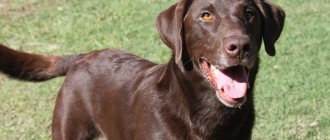Large, beautiful, friendly dogs can often be seen in photographs and pictures depicting happy, friendly families. The Labrador breed, whose characteristics usually begin with positive traits, is considered ideal for families with children. Is it really?
From our article you will learn everything about Labrador dogs. We will tell you what kind of character and temperament a Labrador has, what makes these dogs good, what types of breed there are, what you need to know about the disadvantages of these dogs.
Description of the breed
The Labrador is a dog that was bred for sport and is muscular and athletic. She has a short and easy-to-groom coat, a friendly demeanor, a sharp mind and a ton of energy. This dog is very loyal, deeply loyal to its owner. Labradors are generally very human-oriented; they seem to live only to serve and protect people; some dog owners attribute magical properties to the Labrador and compare it to an angel.
The Labrador breed originated on the island of Newfoundland, on the northeast Atlantic coast of Canada. At first, the Labrador was named St. John's dog and was bred to help pull fishing nets out of the ocean, carry ropes, weights and any small luggage. But thanks to their character and love, devotion, Labradors began to be bred further as a family dog. Watch a video about Labradors:
Photo
You have become acquainted with the Labrador breed, the photo of which is presented above. A responsive, trusting, friendly, kind dog with an incredibly “cozy” appearance is the dream of any owner. Labrador is very family-oriented and loyal. This explains why young couples prefer to have this breed.
Interesting facts about the breed
The Labrador is the only dog with webbed feet. This structural feature makes them unsurpassed swimmers in the canine world.
Dogs love to hold objects in their mouths. They have a soft jaw, but the owner must ensure that the pet has more toys. Otherwise, he will switch his attention to other objects in the house.
Labradors have a very high pain threshold. It is not surprising that they are selfless and can rush into the very center of a fire or disaster in order to save people.
They have a sense of smell that is 25% higher than that of the German Shepherd.
The breed, along with the English bulldog, Pekingese, boxer, and German shepherd, is among the TOP 7 most popular breeds.
Labrador personality
These dogs are very affectionate, loyal to the point that they are considered therapy dogs. They enjoy playing with children and entertaining older people. Unfortunately, the nature of the Labrador does not allow him to be a guard dog, because he happily greets an intruder and gladly shows him all the secret places in the house. The Labrador Retriever has proven its usefulness to humans for centuries - it has been a companion and assistant to a fisherman, helped shepherds, performed well at shows, and is now an excellent working dog. He was different, but one quality remained unchanged - the Labrador is an excellent conversationalist and friend.
Training
For their intelligence and intelligence, representatives of this breed occupy 7th place in the top ten smartest dog breeds. They are easy to train, following commands with joy, trying to please their owner. You just have to learn how to hold their attention, which is the main difficulty when training them.
It has been experimentally verified that the memory of Labradors is capable of retaining up to three hundred human phrases. Although they do not sit at the top of the pyramid of smartest dogs, their desire to please their owner makes the training process easier. You can teach him a lot. From the minimal “come to me”, “next to me”, “sit”, “lie down”, “place” to opening doors for the owner and turning off the lights on command.
You can achieve successful execution of commands with a Labrador at any age, but it is still better to start from the first days the puppy appears in the house.
To make the training of a young individual as comfortable as possible, you need to follow simple rules:
- If you complete the task, you receive a reward, and it’s not always a delicacy.
- The dog receives a reward only if the task is completed correctly and completely.
- You should not start new commands until the old ones are fixed.
- The location where the first classes will be held is important. There should be no distractions.
- The main thing in training is not to overdo it. It is necessary to give the dog a rest.
- Training should be done before feeding.
These simple tips will help you succeed in training your pet.
Breed Features
Labrador retrievers love to eat and very often suffer from obesity, because it is so difficult not to overfeed them. Limit the number of treats, give your dog more exercise and food regularly, and do not leave food unattended.
Due to such a feature as a tendency to overeat, the dog is constantly looking for something to eat - food, garbage, children's toys. She is very picky about food. Labradors have a lot of energy, so they need to move and move, with a minimum of 30-60 minutes of exercise daily. If they are not busy, they will start annoying their owners by barking and chewing.
However, Labradors have such a good reputation that people often think that they don't need to think about special training. But Labradors are large and very energetic animals and need to be trained to be a good dog. When your Labrador is still a small puppy, sign up for special puppy training courses, preferably as soon as you bring your Labrador home.
Many people mistakenly think that Labradors are hyperactive, but this is not true. They are simply curious and active. A Labrador puppy is definitely very lively, but as he gets older he becomes more sedate. But still, Labradors remain active throughout their lives.
Behavior in the apartment
Is it possible to keep a Labrador in an apartment? Yes, but with certain conditions. The owner is obliged to take long and frequent walks with the dog. That is, either family members distribute time, who walks him and when, or the owner must have enough free time from work. Based on the description of the nature of the breed, in an apartment a Labrador, if the owner fails to fulfill his duties, can gnaw furniture, tear up wallpaper, and tear things. To prevent this from happening, the owner must walk the pet for a long time and often, and arrange games for it. Minimum two hours a day.
As mentioned earlier, representatives of this breed are very attached to their owner. The dog cannot be separated from him for too long; it is painful for him. Even if a person went out for half an hour to shop at the nearest store, not to mention an eight-hour working day.
How to train a Labrador
In order for your dog to listen to you, you need the right motivation. Promise your dog something tasty (let him smell it) and the Labrador will move mountains. But first, make sure your pet has a microchip or identification tag - a Labrador can run far and get lost.
By the way, Labradors are the most frequently lost dogs, since not all owners keep up with them.
How to choose a Labrador
There are many Labrador kennels offering Labrador puppies. You need to find kennels that are interested in increasing demand for this breed - for example, they often publish information about this dog. And also this kennel should be interested in breeding dogs with excellent health and good temperament.
If you want to get a healthy puppy, never buy a puppy from an unscrupulous breeder or pet store. Look for a reputable breeder who conscientiously tests dogs for genetic diseases and temperament problems.
When you start looking for a puppy, you will find that Labradors are different from one breeder to another. Some breeders specialize in Labradors that participate in sporting competitions, while others bring the dog as close as possible to the breed's temperament. You may even come across breeders who breed Labradors of a certain color or usefulness.
Labradors for show are often heavier than those sent as family companions.
History of the breed
The Labrador Retriever was bred on the island of Newfoundland, on the coast of Canada. This dog was originally called the St. John's dog. Labradors served as companions and helpers to local fishermen in the early 18th century. The dogs worked all day with the fishermen - they helped catch fish that had fallen off the hooks, then they returned home with the fishermen and spent the evening entertaining the fishing family, especially the children.
It is further believed that the St. John's dog was crossed with the Newfoundland dog and small water dogs. And such a hybrid was noticed to have improved useful qualities and a good disposition, and athletes from England brought some of the dogs to England. This was already in 1830. It was the English Earl of Malmesbury who first named this dog a Labrador.
Now this dog is the most popular in America. Surprisingly, by 1880 these dogs were almost extinct, but the family of the Earl of Malmesbury and some other fans of this dog breed saved the breed. Owning a female dog was heavily taxed, so female puppies were often discarded from litters. But nevertheless, this breed survived in England; the famous Kennel Club recognized the Labrador breed as an excellent breed in 1903. In the 1920s, this breed was sent to the USA for breeding. During the Second World War, the Labrador breed became very popular in America, and in 1991 throughout the world. Since then, the Labrador has been the most popular companion dog in the world.
Labradors are excellent rescue dogs, with a good sense of smell, they are used to detect drugs and explosives, search and rescue people. These dogs have proven themselves as guide dogs for blind people and the disabled. They succeed in all areas, which is why they are so popular and loved all over the world.
Labrador health
The Labrador Retriever is generally in good health, but still has a tendency to certain diseases. Not all Labradors can develop these diseases, but they are important to be aware of if you are considering purchasing this dog.
Hip dysplasia
This is an inherited condition where the femur bone does not fit tightly to the hip joint and the dog may experience pain and limp. Sometimes the disease is asymptomatic, but as the dog begins to age, it may develop arthritis.
To check a Labrador for the presence or absence of hip dysplasia, you need to take an x-ray. If a dog is diagnosed with this disease, it should not be bred.
If you want to buy a Labrador Retriever puppy, you must ask the breeder for the results of testing the puppy’s parents for hip dysplasia.
Elbow dysplasia
It is also a hereditary disease common to Labradors and all large breed dogs. It is caused by different growth rates of the three bones that make up a dog's elbow and causes joint weakness. The disease results in a painful lameness. Your dog may benefit from surgery or pain relief.
Osteochondrosis
This is the abnormal growth of cartilage in the joints. Typically occurring in the elbow joints of the paws, it causes a painful stiffness of the joint so that the dog cannot bend the paw. The disease already appears in puppies aged 4-9 months.
Feeding your puppy "growth formula" or high protein foods can cause this condition.
Cataract
Just like in humans, cataracts in retrievers are characterized by cloudy spots on the lens of the eye. The spots may grow over time. Cataracts in dogs can occur at any time, at any age, and impair vision, sometimes leading to severe vision loss. Cataracts are corrected with surgery.
Progressive retinal atrophy
This is a family of eye diseases that involves the gradual deterioration of the retina. At the onset of the disease, dogs lose night vision, then day vision. Many dogs adapt well to limited or complete vision loss.
Epilepsy
Labradors can suffer from epilepsy, which causes the dog to have mild to severe seizures. Seizures may involve unusual behavior, such as running fast as if being chased, or dogs may stagger and fall. However, the prognosis for dogs with epilepsy is very good. We must remember that seizures can be caused not only by hereditary epilepsy, but also by metabolic disorders, infectious diseases of the brain, tumors, exposure to poisons, severe head injuries and many others.
Tricuspid valve dysplasia
This is a congenital heart defect, the prevalence of which is high in Labradors. Labrador puppies are born with this defect on the right side of the heart - some dogs live with this defect their entire lives asymptomatically, others die. The defect can be detected by performing an ultrasound of the dog's heart.
Diseases
Every breed of dog has a predisposition to certain diseases. Labrador retrievers are no exception to the rule. To prevent health problems, it is necessary to carry out timely examination, vaccination and deworming.
Here are the most common diseases in Labradors:
- Obesity.
- Dysplasia of the hip or elbow joints.
- Panosteitis.
- Osteochondrosis.
- Licking granuloma.
- Retinal atrophy.
- Cataract.
- Epilepsy.
The likelihood of the occurrence and development of diseases in representatives of the Labrador Retriever breed can be reduced using gene mapping, but the risk still remains.
Labrador Retriever Care
The Labrador Retriever should live in a home with the family. This is not a dog for an outdoor kennel. If he is left alone for too long, he is likely to tarnish his excellent reputation: a bored Labrador may dig, chew everything around him, or find rather destructive solutions to release his energy.
Labradors have varying levels of physical activity, depending on the age of the dog. But they all need activity, both physical and mental. Taking daily 30-minute walks, playing in the park with other dogs, or playing leash play will help your Labrador get out his energy. However, if you have a Labrador puppy, you should not take him on long trips. A puppy only needs to play for a few minutes several times a day.
Labrador Retrievers are considered “workaholics” and very often they can play or exercise without stopping. The end time of a game or training session is up to you.
Some owners believe that Labradors are already good and do not need training or any training at all. But this is a mistake. Without training, a Labrador puppy will grow into a very large and very noisy dog. Fortunately, Labradors are good learners and have no equal in obedience competitions.
Look for special kindergartens for retriever puppies or train your puppy yourself. A commonly used technique is to reward good teaching. By the way, that's the only thing that works. You need to reward your dog for everything he does right and ignore what he does wrong. Particular care must be taken here. If you draw your dog's attention to her incorrect behavior, she will definitely repeat it, just out of curiosity to see your unusual reaction again.
Do not allow your Labrador puppy to run and play on very hard surfaces, such as pavement, until he is 2 years old and his joints are fully developed. Playing on the grass is not prohibited. Like all retrievers, Labradors love to bark, he will be happy if he can take something in his mouth. Always have hard, large toys with you that will prevent your Labrador from chewing your sofa or eating all the leaves in the park.
Keep all documents and magazines or books that are important to you on shelves, behind closed doors, or put them away in a desk. Make sure that your Labrador does not get in the way of things or food that he should not chew. Be especially careful with medications and chemicals.
The Labrador is a curious dog and always wants to chew something, so it will climb everywhere and find what it needs, but it is often harmful and can lead to a sad outcome.
How active are they? What kind of people is it suitable for?
Labradors, thanks to their sociable nature and ability to adapt to new conditions, easily adapt to the habits and lifestyle of their owners . Perhaps the only thing they cannot come to terms with is a passive lifestyle.
Therefore, elderly people and those who cannot devote enough time to walk with their pet should not get a dog of this breed.
These are dogs for those who lead an active life, are interested in hunting, sports, tourism and simply do not like to sit still.
The owner of a Labrador must be a strong-willed person with a strong character, a leader who will not let the dog get bored and can direct its energy in the right direction.
What to feed a Labrador
The main thing is not to overfeed a Labrador. Try not to exceed the recommended daily food intake of 2.5 to 3 cups (200g per cup) of high quality dry food per day. This amount must be divided into two meals.
How much your adult dog eats depends on his size, age, build, metabolism and activity level.
Dogs have their own personalities, just like people, and they need their own amount of food.
Of course, an active dog needs more food than a couch potato. The quality of the food is also of great importance - the higher the quality of the food, the longer it will keep the dog full. Don't leave food in the bowl, but make sure your dog eats twice a day.
To determine whether a Labrador is eating enough, do this test: look at the dog from top to bottom - you should see his waist. Now place your hands on the dog's back, with your thumbs along the spine and the rest of your fingers spread. You should feel the dog's ribs with your fingers, but the ribs should not be visually visible. If you can’t feel the ribs with your fingers, your dog is overfed; if you see the dog’s ribs, it means you are not feeding your Labrador.
Labradors grow very quickly from four months to seven months - try not to feed the dog too high-calorie food during this period, otherwise it will develop bone problems.
Appearance of Labradors
Smooth and easy to care for, the Labrador coat has two layers: a short, thick undercoat and a straight, soft topcoat that is water and wind resistant. This coat protects the retriever from moisture and cold.
The wool comes in three colors - chocolate, black and gold.
The black Labrador has a black coat, but the most popular is the golden Labrador or golden retriever. Chocolate Labrador is also very popular. Some breeders specialize only in Golden Retrievers, while others only breed Chocolate Labradors.
Recently, breeders have begun breeding colored Labrador Retrievers, with a mixture of white and red colors. In fact, colored Labradors are not uncommon - they are a type of Golden Retriever.
Labradors need bathing every two months to keep them looking clean and smelling good. If your Labrador is lying around in a muddy puddle or dust, then, of course, it needs to be washed more often.
Brush your dog's teeth at least two or three times a week to prevent tartar and bacteria from building up. Brushing your teeth daily is even better, especially if you want to prevent gum disease and bad breath.
Labrador Retrievers need to trim their nails twice a month if the dog does not wear them down naturally. If you hear paws clicking on the floor, it's time to trim your dog's nails. This will keep you safe from scratches when your friendly Labrador greets you.
You should check your Labrador's ears weekly for redness or a foul odor, which could indicate an infection. Clean your dog's ears with a cotton swab soaked in a mild PH balanced cleaner to prevent infection from spreading. Don't insert anything into the ear canal—just clean the outer ear.
Clean ears especially after bathing or when your dog gets wet. Start getting your dog used to being examined by a veterinarian when he is a puppy. Hold his paws often—dogs are sensitive to their paws—and look into his mouth.
Make grooming a regular and positive experience by giving your dog a treat after grooming.
Check your dog's skin regularly for any signs of infection - sores, rashes, redness, tenderness.
The dog's eyes should be clean - without redness or discharge.
Prices
The price of the Labrador breed depends on many factors. Here are the main ones:
- Color. Chocolate Labrador is quite rare; fawn and black puppies are born more often.
- Parents' title. The title indicates that mom and dad meet the breed standard.
- Prestige of the nursery. A puppy purchased from a well-known nursery will cost more than one purchased through an advertisement or on the market. But you will be sure that you bought a purebred Labrador.
- Litter quality. All puppies in it must be healthy, vaccinated, treated for worms and parasites.
- Class: pet class (pet), breed class (dog for further breeding), show class (for exhibitions). The last class is the most expensive.
- Gender of the puppy. Bitches are more expensive than males, because in the future they will give the owner the opportunity to earn money by selling puppies.
- Number of puppies in the litter. The fewer babies are born, the more expensive they will be - the breeder needs to recoup the costs associated with mating, pregnancy and childbirth of the bitch. In addition, owners cannot always sell puppies in a timely manner when there are a large number of them in the litter.
- Current price in the consumer market. The cost of a Labrador puppy in large cities will be much higher than in the provinces.
- Puppy age. A grown up Labrador can be purchased inexpensively.
How much does a Labrador cost in Russian nurseries? On average, a purebred puppy, supplied at the nursery with all the necessary documents, will cost from 30 to 60 thousand rubles. Breeding dogs (with certain defects) are sold several times cheaper and, provided that they are not bred and exhibited, documents for them are not issued. The cost of such puppies is on average about 10 thousand.
However, buying a small Labrador is the least expensive of those that will have to be incurred in the future: high-quality food, veterinarian services, toys, enclosure equipment.











